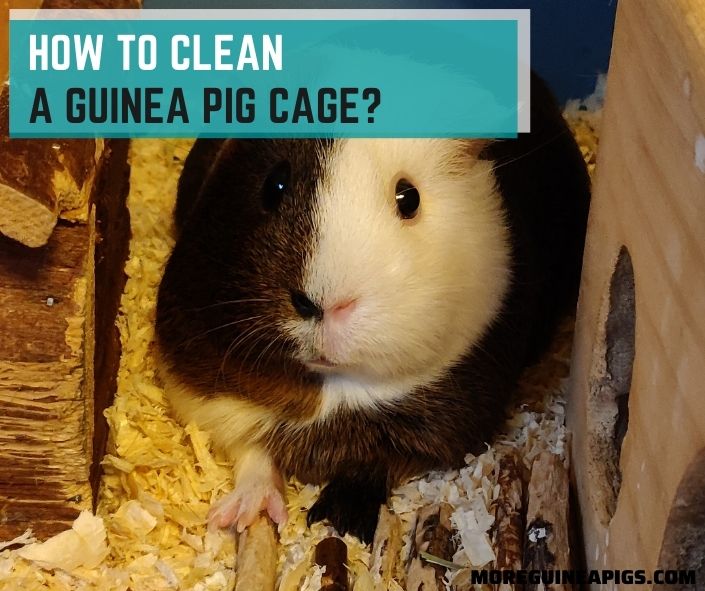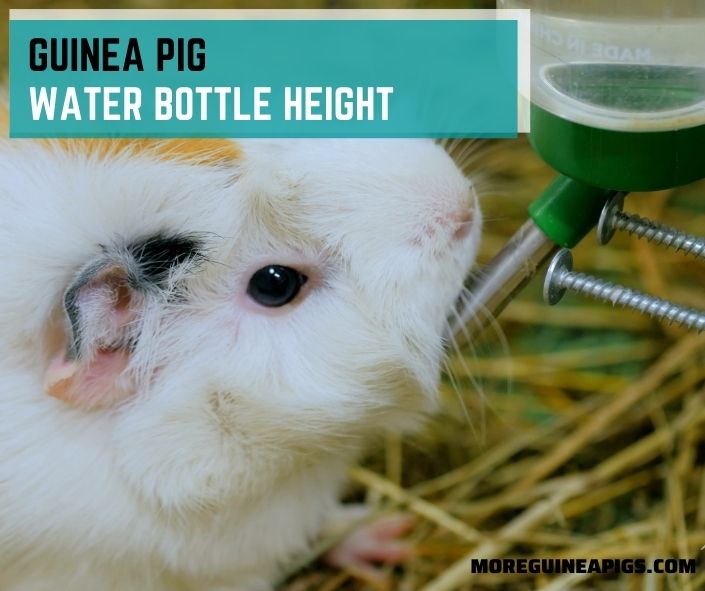How To Clean a Guinea Pig Cage?
Guinea pigs’ happiness goes beyond spending the most time with them as a pet owner. A clean cage makes a guinea pig happy. A happy guinea pig is stress-free, and its health gleams.
You may wonder how to clean your guinea pig cage effectively and unlaborously? What are the steps involved in this activity? How often should you clean the cage? Would it make sense if you leave your piggy to live in a dirty cage?
Amazingly, this article provides you with insights that will definitely quench your curiosity. And also inform you of the tools you will require during the cleaning process.
What Do You Need to Clean Your Guinea Pig’s Cage?
The first and foremost things to gather when you prepare to clean your guinea pig’s cage are the right tools. If you have them all together, it saves you from the unnecessary movement after you have started cleaning.
You don’t need to travel to far off places to buy your tools; they’re readily and easily accessible around your local store. Below is a list of tools you need to clean your piggy’s cage.
- Spray bottles
- Rags or sponges
- Scrubbing brush
- Paper towels
- Dust puns or scoopers
- vinegar
- Garbage bags
- Disposable plastic gloves
If your pocket is friendly, you can opt for commercial cage cleaners. Look for a cage cleaner designed specifically for small animals, and it should be free from the harsh scent.
If you’re not able to get a cage cleaner, a distilled white vinegar and water solution is effective in cleaning. Make your cleaner by mixing distilled white vinegar and water in a ratio of 1:1.
How to Clean a Guinea Pig Cage in 6 Steps
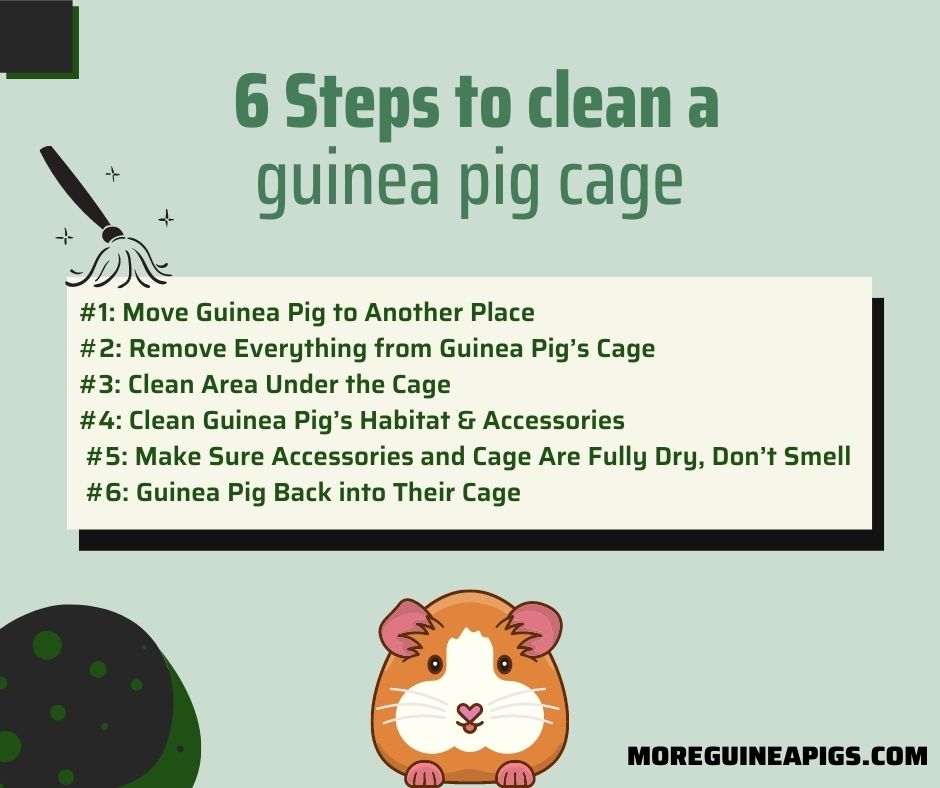
Your guinea pig needs to be clean throughout, and the pet depends on you to make it happen. Maintaining your pig’s cleanliness prevents diseases and offers a conducive and comfortable place for your pet to thrive.
Cleaning the cage is simply an easier and more fun process that you would surely enjoy. This activity involves several steps that are easier to follow through, including:
Step #1: Move Guinea Pig to Another Place
First, identify where you want to place the guinea pig. Then ensure the place is secure in that the guinea pig won’t escape. And that no other larger pets are around to frighten it.
Also, ensure there are no loud noises around to avoid frightening and stressing your guinea pig.
After confirming that your pig will be safe in its temporary home, you can go ahead and move the pet to the place.
Place the pig down gently to its temporary location and provide some favorite treats to let the pig enjoy itself as you continue with your work.
Step #2: Remove Everything from Guinea Pig’s Cage
After taking the guinea pig out, the next thing will be to empty the cage. Working on an empty cage makes cleaning easier and allows you to clean all the crevices.
Hey, please don’t throw out the accessories after removing them from the cage. You need to put them in a safe place and clean them eventually. Guinea pig accessories include;
- Food bowls
- Water bowls
- Hiding toys
- Hay racks
- Litter box
- Beddings
- Chewing toys
Step #3: Clean Area Under the Cage
Here, you should remove everything you put under your piggy’s cage, that is, the cage liner. It’s necessary to remove and replace liners to prevent wetness.
Likewise, remove all substrate materials from the cage and dispose of them in a garbage bag. To make your work easier, make use of a scooper and brush. It’s advisable to put on disposable plastic gloves.
You may want to clean the cage outside the house or use a tub. Clean the area under the cage thoroughly with a vinegar solution, and be sure to dry it.
Step #4: Clean Guinea Pig’s Habitat & Accessories

Before you embark on cleaning the habitat, you must clean the accessories first and give them time to dry as you continue cleaning the cage.
If the accessories dry properly, no moisture can get trapped in the beddings, which corrects mold issues. Soaking the accessories in a vinegar solution for some time will be a safe way to disinfect them.
Use hot water, antibacterial soap, and a rag in the cleaning. Rinse everything thoroughly with clean water and leave them to air dry.
Now it’s time to clean the habitat. Take the enclosure to where you will clean it from, and confirm it’s empty from any bedding materials. Use the mixture of a mild detergent and hot water to scrub the cage.
Spray the entire cage with vinegar solution and allow it to rest for around 10 minutes for proper disinfection. Vinegar solution helps kill any bacteria and all harmful elements in the enclosure. It will effectively clean up urine too.
Subsequently, rigorously rinse the cage out with hot water and leave no residue from the disinfectant.
Step #5: Make Sure Accessories and Cage Are Fully Dry, Don’t Smell
You wouldn’t want to leave the cage wet for many reasons. For instance, wet cages/beddings are breeding grounds for mold, fungal infections, bug infestations, etc. It’s also disgusting for the pig to experience wetness.
Make a good sniff to the cage and if the vinegar scent is still strong, go ahead and rinse it again. The accessories should also be free from the scent.
You aren’t done with cleaning until you dry the enclosure. Use a paper towel to dry the cage, and allow some time for air-drying. But the latter won’t be necessary if you completely dry the enclosure leaving no dumpiness behind.
Ideally, the cage needs to be 100% dry to avoid any potential illness to the pet and provide a comfortable and neat environment.
Also read:
Step #6: Guinea Pig Back into Their Cage
Now that you have a clean and dry cage, it’s the right time for rebuilding the habitat. Return the cage to its position, and line the bottom with an ideal liner. Best liners are capable of absorbing both liquid and odor.
The guinea pig ideal liners list is broad; you can choose the type that favors you or you prefer to use. After setting the bedding, arrange the accessories back into the cage.
Some people would want to reposition the accessories, which is fine. Guinea pigs are curious animals; it gives them an exciting adventure.
Fill the water bowl with clean water, provide feed pellets and hay, and bring the pig back to the house. Your pig may be unable to say thank you, but you will see it’s excited.
How Often Do You Have to Clean a Guinea Pig Cage?
It’s not about how much you love your guinea pig, but what matters most is giving a quality life to your animal companion. Cleanliness is a fundamental prerequisite when it comes to keeping guinea pigs.
Guinea pigs eat and egest frequently; hence, they are likely to eat any waste left in the house, and you won’t like the results. If the house is messy, your pet won’t love residing there; it triggers stress.
They rely on you to maintain them clean. Thus, cleaning your piggy’s cage more frequently is paramount. They require minor activities, including spot-cleaning, discarding food remains, and cleaning the utensils.
Even on a daily cleaning basis, thorough cleaning of the cage once a week is recommended. And this is where you clean everything, from all the accessories to the entire cage. Some people may plan their cleaning schedule every month.
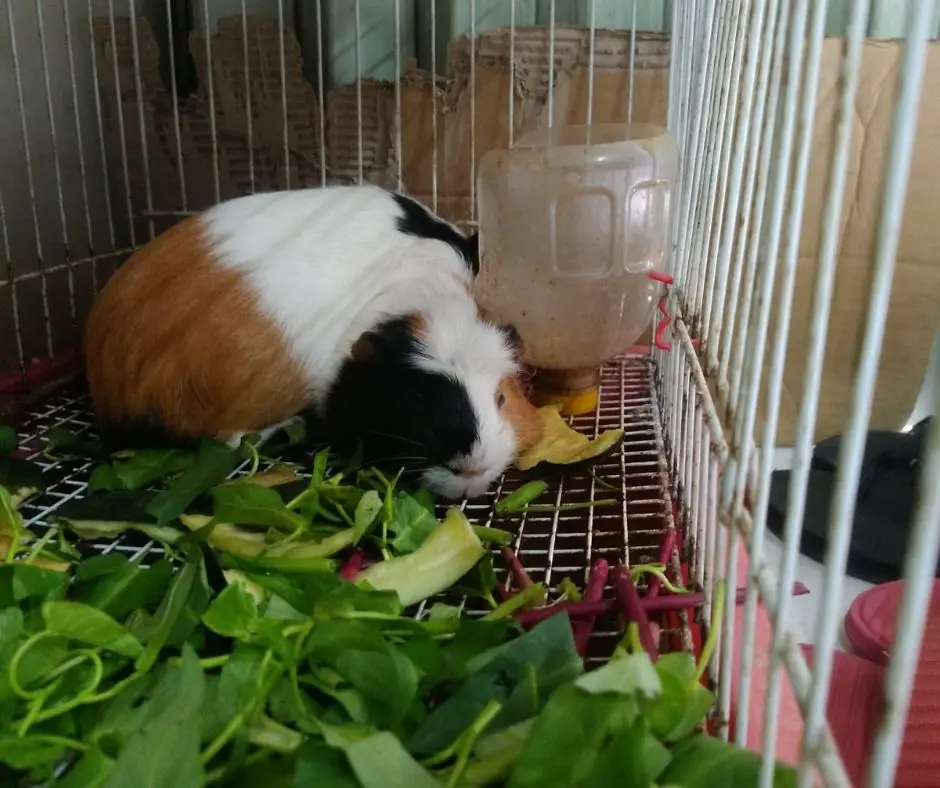
Daily Cleaning: Things That Need to Clean Spot
Spot cleaning is the easiest cleaning possible and consumes only a little of your time. It requires only flipping through the cage and seeing if you can see any dirty spots. Sweep up and tidy any piles of waste.
Then, pick a damp paper towel and spot clean the cage. Look for any overly soiled beddings and change them. It also requires you to discard waste food and clean the food containers and water bowls daily.
Wash them in hot, soapy water, and perfectly dry every item. Return these accessories to the cage, refill water to the water bowl, and provide fresh hay and food pellets.
Dry any water that may spill in the cage, and remove any affected hay or food. If this is achieved, your pet always lives in a healthy surroundings. It also reduces the risks of health complications.
Things That Need to Clean Weekly
The weekly cleaning should be more efficient and deeper than daily cleaning. Daily spot cleaning should not be your only cleaning schedule; it’s not enough for a guinea pig.
These cavies engage in many activities daily that bring piles of dirt inside. They poop and urinate in the cage; they groom themselves and eat from the cage too. Weekly cleaning helps to remove unnecessary stinks from the cage.
At this point, you have to clean all accessories, change the beddings, and clean the enclosure too. You achieve this by emptying the cage, disinfecting, scrubbing, and rinsing it rigorously. Also, disinfect and clean the accessories and then dry them up.
Keep everything dry, from the accessories, cage, and beddings, it curbs the mold issues and blocks the channels for disease occurrence.
Deep Cleaning: Things That Need to Clean Monthly
Monthly cleaning is a bit complex and demands a lot of your time. It’s not something you can complete when rushing. You need enough time for every task to achieve impressive results.
You need to clean the cage and accessories and the guinea pig during a deep cleaning. Take this time as a privilege to do your general house cleaning; I mean areas surrounding your cavy’s habitat.
The best time to clean your guinea pig is when you’re doing a monthly deep cleaning. You know the whole process of cleaning the cage and the accessories too. Bathing your pet is also not a complicated task.
You should bathe the pig in warm water and use guinea pig shampoo as your detergent. Rinse the pet properly to remove all shampoo residues and dry the pig. Nothing needs to be wet, including your guinea pig.
What Happens If You Don’t Clean Your Guinea Pigs Cage?
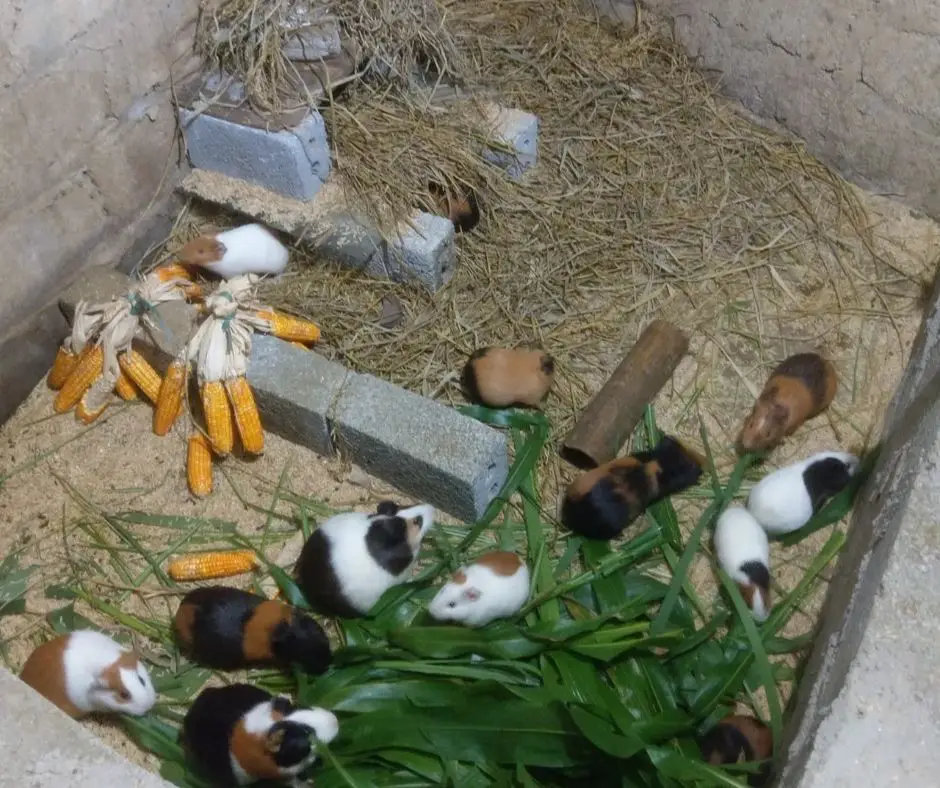
Letting your guinea pig stay in wet fleece or bedding is the last thing you want. Like the way you wouldn’t want to spend even a single hour on wet beddings, your pet also needs such life.
Dirty cages smell awful; they make your pet’s life uncomfortable and unhealthy too. Guinea pigs won’t die abruptly if you leave them in dirty places, but sooner or later, you may lose your pet.
Unhygienic is a primary contributor to many diseases affecting our pets, including guinea pigs. That already is a warning enough not to let your beloved piggy stay in dirty places.
Health Risks When Guinea Pig Cage Is Dirty
Poor hygiene contributes to ammonia build-up, and breathing such air irritates a guinea pig respiratory tract, making the animal vulnerable to respiratory diseases.
Guinea pigs tend to urinate frequently. If not cleaned, the urine will break down into ammonia, which eventually fills the whole house with a foul ammonia smell.
Moreover, this ammonia smell makes the cage susceptible to mold growth. Guinea pigs living in a dirty cage are also at risk of getting bumblefoot infection. Bumblefoot can be hard to treat, especially if it’s acute.
Well, those are not the only consequences of guinea pigs living in dirty cages. Such places are breeding grounds for fungal infections, such as ringworm.
Also read:
- Bumblefoot in Guinea Pigs: Signs, Causes, Treatment, and Prevention
- What to Do If You Found Maggots in Guinea Pig Cage
Do Guinea Pigs Get Happy When You Clean Their Cage?
Yes, guinea pigs get happy when you clean their cage. One thing you shouldn’t forget is that guinea pigs like staying clean because they usually groom themselves.
Your pig will comfortably walk through the enclosure without stepping on any feces, urine, or decayed food. There is nothing to restrict its movement and adventuring in the cage. It makes them happy to stay in a clean place.
How to Keep Your Guinea Pig Cage Clean and Won’t Smell
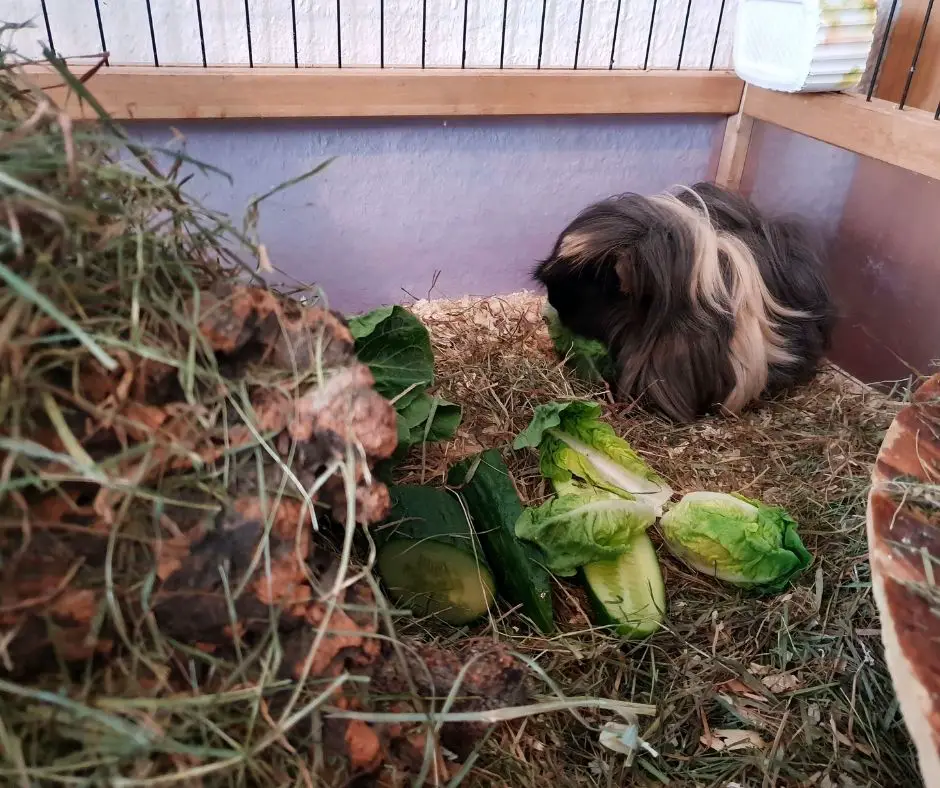
One way to keep your piggy’s cage clean and not smelly is getting a large cage. It prevents waste piling and allows guinea pigs to separate their egestion area from other activities. A larger cage is also easier to clean.
You’ve seen how important it is to maintain guinea pig cages clean—plan to clean your guinea pig’s cage at least once every week. You won’t have problems with foul smells and dealing with guinea pig infections.
It’s a wise idea to litter train your guinea pigs. It will learn to urinate or poop on the same spot. Making use of fleece bedding is also an effective approach. They absorb liquids and smell.
Ensure that your guinea pig ears are free from the crust and white marks. Clean ears won’t be susceptible to infections. Likewise, clean your guinea pig’s scent glands.
The area with scent glands that these cavies use to mark territory can get greasy and smelly, especially for males.
Check this article about Guinea Pig Setup: Step By Step Guide for a perfect guinea pig habitat setup.
Nature’s Miracle Cage Cleaner 24 fl oz, Small Animal Formula, Cleans And Deodorizes Small Animal Cages
Conclusion
Now you know how far you need to go with caring for your guinea pig. It depends on how well you care for your cavy to make them happy and thriving.
And the greatest sure way to please these charming pets is to keep them in clean cages. They want to eat clean food and stay in clean places at all times.
You should plan to clean your pet’s enclosure every day, weekly, or monthly depending on the level of cleaning. Good hygiene protects guinea pigs from becoming sick and cultivates their mood.
Also read: Top 5 Guinea Pig Cages & 7 Factors To Make Perfect Enclosure
